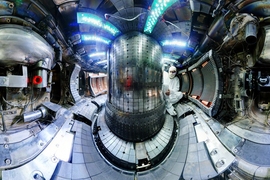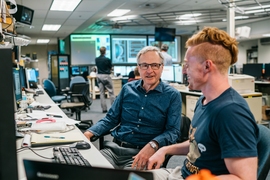It could be the background soundtrack for a science fiction movie. Some sounds bubble up like prehistoric chirps from primordial ooze. Others whirl up and down octaves, quickly joined by a progressive rattling that slinks across the sound landscape.
“That’s C-Mod’s data!” says Professor Joe Paradiso, director of the Responsive Environments Group at the MIT Media Lab. “That sch-sch-sch-sch. Like a snake.”
Or like chattering insects, or a New Year’s Eve noisemaker.
Paradiso is using a modular synthesizer to translate data into artful sound — specifically data from one of the final fusion experiments on the Plasma Science and Fusion Center’s (PSFC) Alcator C-Mod tokamak. Late on Sept. 30, 2016, this experiment set the plasma pressure record for a magnetically confined fusion device. To emphasize the connection between the scientific data and the soundscape it augments, Paradiso has temporarily located his project at the PSFC near the cell where Alcator C-Mod is still housed.
“That’s the beauty of having it here,” he enthuses. “It’s a great space; it has the right ambiance. It’s very inspirational.”
The installation, entitled “Resynthesizer,” is a collaboration between the Department of Nuclear Science and Engineering, the Program in Art, Culture and Technology (ACT), the PSFC, and the Media Lab. The partners in the project are offering a month-long series of public tours of the synthesizer and the Alcator C-Mod tokamak at the PSFC, intending to promote dialogue between the varying departments, and the public, concerning interdisciplinary research efforts directed towards one of the 21st century’s most pressing challenges: to produce the next clean, economically efficient, and sustainable energy.
Nuno Loureiro, a nuclear science and engineering professor who was instrumental to locating the synth at the PSFC, sees a conversation beginning.
“This is one of those rare instances where we are connecting parts of campus that don’t traditionally talk to each other,” he says. “And that’s exciting for everybody, especially the students. They are intrigued to think about art in the context of science, and science in the context of art.”
The Paradiso Synthesizer, arguably the world’s largest homemade modular synthesizer, produces sounds which have been programmed manually by running wires between various outputs and inputs. Unlike today’s digital synthesizers, which normally hide their many capabilities behind menus or graphical interface screens that allow for changing only one parameter at a time, the modular synthesizer exposes all aspects of sound creation and modification simultaneously via the physical modules.
The modules produce complex and varied sonic environments from a complicated patch — or set of connections — that Paradiso creates. The patch determines the sounds, as well as how they are controlled and triggered, ensuring that the sonic environment generated by the synthesizer will never be repeated.
To create his atmospheric soundscapes, Paradiso modifies the sounds in several ways.
“Once it is converted to audio, I process the C-Mod data with various effects, including clocking it at different rates, as well as dynamically selecting data files made from different variables from the experiment,” he says.
Paradiso says he was inspired by the haunting sound of C-Mod data to “fortify this mood” with other modified and heavily processed sounds, some taken from oscillators and speech generators, as well as triggered elements from commercial keyboards, but much of this sound is also modulated and controlled by C-Mod data.
“I tried to keep it, not dark, but more mysterious,” he says. “I couldn’t make it happy. It’s not really happy. It’s otherworldly.”
Paradiso plans to install new and different patches at intervals over the next weeks, possibly altering the mood of the work.
Loureiro sees parallels between this sonic art and fusion research.
“With the synth, minor changes in the patch produce completely different outcomes, just as in fusion experiments slight changes to a variable creates a completely different fusion reaction. Both are nonlinear systems that can behave completely differently depending on the input,” he says.
Paradiso, who introduced the resynthesizer in April as part of ACT's 50th Anniversary celebration of the Center for Advanced Visual Studies (CAVS), says he was pleased with the process and the results. Having spent hours setting up the synthesizer near the C-Mod cell, he even became fond of the omnipresent noise of a vacuum pump and exhaust fans, despite his early concern that they would interfere with his own soundscape. Now he plans to sample the background noise of the C-Mod cell for inclusion in future compositions. Because he completed his PhD in experimental high-energy physics here at MIT in 1981, he says he feels at home around a physics experiment.
“It’s great to be an artist — it’s too easy these days to let my students have all the creative fun. I want to make more pieces with it and it and build out its repertoire,” he says. He proposes a jam session with students from the Media Lab joining PSFC researchers for musical encounters with the synthesizer. Graduate students who have studied C-Mod data for their own PhD theses could be jamming with it before the end of the month, collaborating with that data in a whole new way.
Public tours of the facility and installation are available Wednesday evenings from 6:30 - 7:30 p.m. through June 6. The tours are cooperatively led by a team of ACT and PSFC graduate students holding special interest in and knowledge of the project. Tours are scheduled and are limited to 20 attendees at a time.
Anyone interested in hearing more can visit the resynthesizer online for what it is currently streaming.










